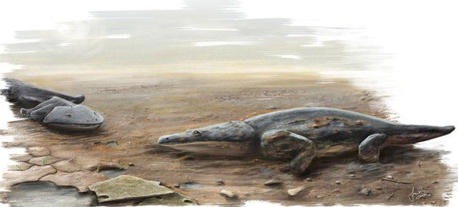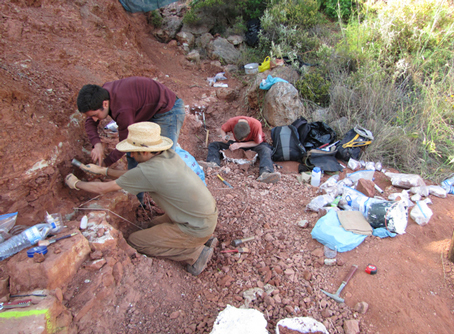Metoposaurus algarvensis – Triassic Predator the Size of a Door
Portugal may have earned a deserved reputation for being the Jurassic dinosaur fossil capital of Europe, but more ancient sediments provide equally fascinating insights into life on our planet just as the Dinosauria were beginning to diversify and dominate terrestrial ecosystems. Step forward (or more appropriately waddle forward), Metoposaurus algarvensis a new species added to the Metoposaurus genus described from a bone bed found in the Algarve region of southern Portugal.
A team of international scientists which include Dr Steve Brusatte (University of Edinburgh) and J. Sébastien Steyer (Centre de Recherches en Paléobiodiversité et Paléoenvironnements, Paris), Dr Richard Butler (Birmingham University) and Professor Octávio Mateus (Museu da Lourinhã, Portugal) have been studying the fossilised remains of several individuals that apparently died together when their lake dried up.
A Pair of Super-sized Amphibians Await Their Fate as the Lake Dries Up
Picture credit: Joana Bruno
Metoposaurid Fossils
Metoposaurid fossils are known from Europe, Africa, North America and India, although this is the first time fossils relating to this genus have been discovered in the Iberian peninsula. Some of the fossil specimens indicate that these amphibians reached lengths in excess of two metres and the shape of the skull along with other anatomical differences between the Portuguese fossils and other material known from Poland and Germany has permitted a new species to be erected.
The bonebed that contains the remains of numerous individuals, ten skulls have been excavated so far, was discovered more than thirty years ago, but not properly mapped and explored until 2009 when the dig site was relocated. Although, these predators superficially resemble a modern salamander, scientists debate whether the Order Temnospondyli which the metoposaurids are part of, are actually closely related to extant amphibians.
The Scientists at Work Excavating the Bone Bed
Picture credit: Steve Brusatte/Richard Butler/ Octávio Mateus/J. Sébastien Steyer
Metoposaurus algarvensis
Although the mouth was large and lined with many sharp teeth, the thick-set body was supported by relatively weak limbs. It is very likely that M. algarvensis spent a great deal of time in water, the fossils of these large amphibians are associated with strata laid down in lake or river environments (lacustrine and fluvial environments).
These animals were probably ambush predators catching fish with rapid movements of their large mouths from side to side. They may also have ambushed unsuspecting small creatures, even some small early dinosaurs as these animals came down to the waters edge to drink. They would have been very capable swimmers but the small legs would have made movement on land rather clumsy and awkward.
Three European species of Metoposaurus have now been described (M. diagnosticus from Germany, M. krasiejowensis from Poland and M. algarvensis from Portugal). Some of the German fossil specimens indicate amphibians approaching 3 metres in length, however, the majority of the temnospondyls became extinct by the end of the Triassic. The Portuguese bone bed evidence further supports the theory that these large animals were confined to very wet habitats with lots of freshwater and therefore the sort of areas that these creatures could live in was much more restricted when compared to the rapidly evolving reptiles such as the crocodiles and the Dinosauria.
The Temnospondyls
As an Order, the temnospondyls probably evolved sometime in the Early Carboniferous and their fossils represent some of the most widely distributed terrestrial fossils recorded in Permian/Triassic strata. Their global range seems to have been limited to low latitudes during the Middle to Late Triassic, a distribution similar to but not identical to the phytosaurs (crocodile-like reptiles that most probably become extinct at the end of the Triassic).
Phytosaurs are archosauriforms and provide plenty of evidence that the long-snouted, fish grabbing, swimming predator form has evolved in lots of different types of animal over the course of the history of our planet. Their more primitive ankle configuration (when compared to extant crocodiles), did not prevent the phytosaurs from evolving into a myriad of different forms.
One Survivor into the Cretaceous
However, apart from some controversial fossils, which most scientists claim are Late Triassic and not Early Jurassic the phytosaurs along with most of the temnospondyls were extinct by around 200 million years ago. However, viewers of the seminal television series “Walking with Dinosaurs” will remember that in programme five “Spirits of the Silent Forest”, which focused on life in the southern polar regions around 106 million years ago, a Koolasuchus makes an appearance. Two fossil jaws found in Victoria, Australia suggest that at least one type of temnospondyl survived into the Cretaceous.
CollectA have introduced a range of Triassic and Jurassic prehistoric animal figures. To view this range: CollectA Deluxe Prehistoric Life Models.








Leave A Comment